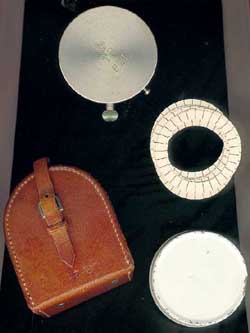URKRYPTOGRAFEN (THE CLOCK CRYPTOGRAPH)
by Niels Faurholt
E-mail : nof(at)mail.tele.dk
ABSTRACT
Supplementary information concerning a Danish military cipher device was first shown in Cryptologia (Cryptanalyst's Corner) by Greg Mellen 19 years ago. The "Clock Cryptograph" is basically a nicely implemented Wheatstone cipher disk. It was in active use in the Danish armed forces from 1934 (or a little earlier) until around 1948.
KEYWORDS
Danish military cipher disk; modified Wheatstone; circa about 1934 to 1948.
IDENTIFICATION
Looking at old issues of Cryptologia, I found on the front page of the January 1984 issue, a Danish cipher disk, and in the "Cryptanalyst's Corner" Greg Mellen1. described the device and asked for more information. With a delay of 19 years (and sadly long after Greg Mellen passed away) here comes some supplementary information concerning this device.
Greg Mellen's description from 1984 is so precise that it cannot be improved, so I will concentrate on some historical details and the operation of the disk, which in Danish is called Urkryptografen (meaning the Clock Cryptograph). The disk described in Cryptologia in 1984 carried the inscription '7 IK" on the rear. 7 IK means 7th Engineer (IngeniLr) Company (Kompagni). The figure 2 underneath, most likely means device No.2 in the company.
Urkryptografen is a Danish product, designed for use in the Danish Army. It was authorized for use by the Ministry of War on 23 June 1936, but it was in active service in the Danish Army at least from 1934. According to the User's Manual the primary use was at divisional and regimental level, but documents reveal that it was used at all command levels from the General Staff and down. It was used by the Navy, too, maybe only for joint operations. Significant numbers of Urkryptografen were produced. After WW2 mechanical cryptographs (Hagelin) replaced Urkryptografen at higher command levels, and in 1947-48 Urkryptografen was replaced at the tactical level by other manual cipher devices that were easier to handle and cheaper to produce.
Urkryptografen is a substitution cipher device, basically identical
with the Wheatstone cipher disk (as Greg Mellen correctly wrote). The outer
ring is made of paper and carries the written mixed ciphertext alphabet.
This paper ring is removable and should be changed often within a given
cipher net. In the back of the device is room for a number of alphabet
rings. For each 360 degree turn of the rings, the outer ring moves one
step (letter) further than the inner ring. The rings must always be turned
in the direction of the arrow. The engraved standard plaintext alphabet
on the inner ring shown on the photograph is for training only. A number
of metal disks with engraved mixed plaintext alphabets were produced and
distributed, some of them reserved for wartime use.
 |
This example of the Urkryptografen is held by by the Museum of Cypher Equipment in Fife Scotland. Click on image to enlarge. (Photo courtesy Museum of Cypher Equipment)
The rings are turned until the black panel on the inner ring is exactly within the black metal frame. The brake (the small button on the side) is then pressed, stopping the inner ring. The outer ring is then turned until a message indicator letter appears in the black metal frame. This is the start position. A new message indicator letter is selected by the operator for each message and later placed in a prearranged position somewhere in the enciphered message.
Encipherment is performed by turning the rings (always in
the direction of the arrow) so that each subsequent plain text letter appears
in the black metal frame in the inner ring; the equivalent cipher
letter is then read in the frame in the outer ring. The black panel indicates
new word and Q indicates shift to figures and symbols and back again to
letters. X replaces every second letter (or figure) in double-letter (or
double-figure) combinations.
 |
Decipherment is performed in the same manner, but cipher letters
are read in the outer ring and the equivalent plain text letters found
in the inner ring. Operation is not particularly easy. Before the actual
encipherment, the plain text message must, according to the manual, be
rewritten twice with the appropriate Q's", X's" and symbols inserted. The
manual also prescribes that operation of
Urkryptografen must be performed by a team of two operators, hardly
an economical use of manpower, as seen through to-day's eyes.
REFERENCES
1. Mellen, Greg. 1984. Cryptanalyst's Corner. Cryptologia. 8(1): 55-57.
AUTHOR'S BIO
Niels Faurholt, born in 1934, is a major (retired) in the Danish Army Signal Corps, with a keen interest in old Danish cipher devices, both military and civilian.